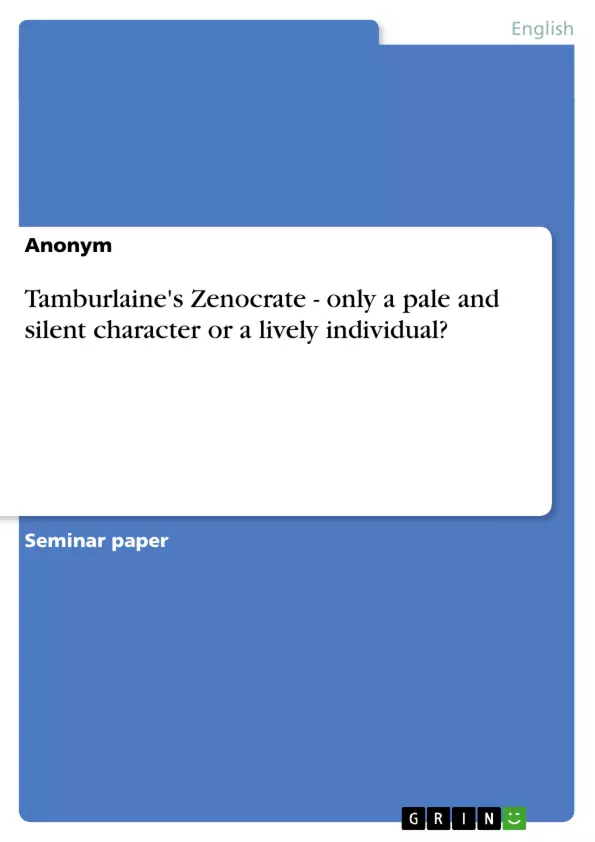Christopher Marlowe’s play Tamburlaine has often been analysed in respect of various factors and characters including power, the motive of overreaching, religion and many more. What has been treated with less interest is the role of females in this play. As C. L. Barber states, Marlowe “knew the available sources for the history of the great conqueror remarkably well” but the character of Zenocrate is not mentioned in the sources of the historical Timur who lived from 1336 until 1405 and “was widely known in the West as the conqueror of Baghdad (1401) and Damascus (1403).” Therefore it is suggested that Marlowe must have had a special reason for he “created the role of Zenocrate in Tamburlaine out of whole cloth.”
When Part I was first staged in 1587, the society at that time was greatly different in its conception of gender and gender-related attributes in comparison with modern thinking about men and women and their roles in society. It was “highly gendersegregated [and] [d]ifferent physical, emotional and intellectual qualities were ascribed to men and women, and to a significant extent they inhabited distinct social spaces.”
From the traditional patriarchal perspective, therefore, qualities conventionally approved in women - passivity, sensitivity, tenderness, compassion, self-sacrifice, silence - are scorned in men as effeminate. Similarly, the attributes most admired in the male - activity, assertiveness, resourcefulness, resolution, eloquence - are deplored and sometimes even excoriated in the female as unnatural.
Women were therefore commonly characterised as being associated with “the earth, sensuality, personal relationships, imagination, intuition, nature, and so on,” whereas men were perceived as the powerful, mighty, aggressive intelligent human beings who manage politics and war, from which women were mostly excluded. According to these values, “women [in literature often] function as apolitical, moral arbiters and men as monstrous Machiavells.”
Inhaltsverzeichnis (Table of Contents)
- Introduction
- Marlowe's concept of women
- Zenocrate's character
- Zenocrate as captive
- Zenocrate as loving maid
- Zenocrate as equal partner for Tamburlaine
- Zenocrate's influence on Tamburlaine
- Conclusion
Zielsetzung und Themenschwerpunkte (Objectives and Key Themes)
This essay aims to examine the character of Zenocrate in Christopher Marlowe’s play Tamburlaine, challenging the conventional interpretation of her as a passive and insignificant figure. It investigates the reasons behind the dramatic shift in Tamburlaine’s character and analyzes Zenocrate’s potential influence on his actions.
- The portrayal of women in Elizabethan society and Marlowe's plays.
- The role of Zenocrate in Tamburlaine and her influence on Tamburlaine's character.
- The themes of power, ambition, and gender roles in Marlowe's works.
- The concept of gender and its social construction in Elizabethan England.
Zusammenfassung der Kapitel (Chapter Summaries)
The introduction sets the context by discussing the historical background of Tamburlaine and the play's portrayal of gender roles in Elizabethan society. It highlights the lack of information about Zenocrate in the historical sources and emphasizes the significance of her character within the play.
The second chapter explores Marlowe's broader conception of women in his plays. It highlights the contrast between traditional patriarchal values and the presence of more active and assertive female characters in his works, who engage in domains previously considered male-dominated.
The third chapter focuses specifically on Zenocrate's character, analyzing her role as a captive, a loving maid, and a potential equal partner for Tamburlaine. This section examines the various ways she might have influenced Tamburlaine's actions, challenging the traditional interpretation of her as a purely passive figure.
Schlüsselwörter (Keywords)
The key themes and concepts explored in this work include gender roles in Elizabethan society, the portrayal of women in literature, power dynamics, ambition, and the influence of female characters on male protagonists. The essay also examines the social construction of gender and its impact on the representation of characters in Marlowe's plays.
- Quote paper
- Anonym (Author), 2006, Tamburlaine's Zenocrate - only a pale and silent character or a lively individual?, Munich, GRIN Verlag, https://www.grin.com/document/65159



